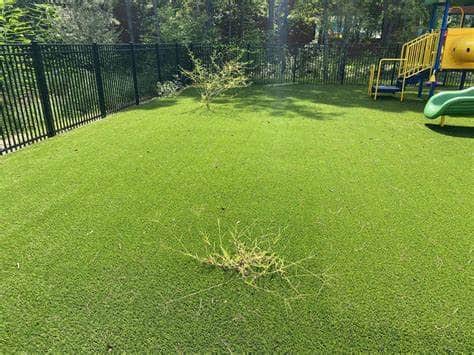How To Prevent Weed Growth In Artificial Grass In Lakeside?
 Artificial grass is a fantastic alternative to natural lawns, offering a lush green space without the hassle of constant maintenance. However, one issue that can occasionally plague artificial turf owners is weed growth. Weeds can be unsightly and undermine the overall aesthetic of your artificial grass. To help you maintain a weed-free artificial lawn, here are five essential tips to keep in mind.
Artificial grass is a fantastic alternative to natural lawns, offering a lush green space without the hassle of constant maintenance. However, one issue that can occasionally plague artificial turf owners is weed growth. Weeds can be unsightly and undermine the overall aesthetic of your artificial grass. To help you maintain a weed-free artificial lawn, here are five essential tips to keep in mind.
- Proper Installation The first step in preventing weed growth in artificial grass begins with proper installation. Ensure that you hire experienced professionals who can properly prepare the base and secure the artificial turf. When the base is adequately prepared, it creates a barrier that makes it challenging for weeds to break through. A well-installed artificial lawn will have a weed membrane or barrier fabric underneath it, which further inhibits weed growth. Additionally, the edges of the artificial grass should be securely anchored to prevent any gaps or spaces where weeds could potentially penetrate. Ensuring a seamless and tight fit of the turf around the edges is vital in keeping weeds at bay.
- Regular Maintenance Regular maintenance is crucial to prevent weed growth in your artificial grass. While artificial lawns require less maintenance than natural ones, they are not entirely maintenance-free. Be sure to remove any debris, fallen leaves, or organic matter from the surface regularly. Organic material can provide a fertile environment for weed seeds to take root. Using a stiff brush or leaf blower can help in keeping your artificial grass clean and free of potential weed growth. Consistent maintenance also includes inspecting the edges for any signs of separation or lifting, which could allow weeds to penetrate.
- Use Weed Barriers and Herbicides In addition to the weed barrier or fabric installed during the initial installation, you can also use weed barriers or geotextiles around the perimeter of your artificial lawn. These barriers create an extra layer of protection against weed invasion by blocking their access points. If you notice any persistent weeds poking through, you can use a safe and approved herbicide specifically designed for artificial grass. Be cautious when using herbicides to avoid damaging the artificial turf, and always follow the manufacturer’s instructions.
- Regular Brushing and Raking Regularly brushing or raking your artificial grass helps in preventing weed growth by disrupting the soil and deterring weed seeds from settling. Brushing also helps maintain the natural look and texture of the turf. Be sure to use a brush with soft bristles to avoid damaging the grass fibers. Depending on the traffic your artificial lawn receives, a quick brush every few weeks should suffice.
- Address Weeds Promptly Even with the best preventive measures in place, weeds may occasionally find their way into your artificial grass. When this happens, it’s essential to address them promptly. Remove the weeds by hand, making sure to remove the entire root system to prevent regrowth. Avoid using harsh chemicals that can damage the artificial turf.
FAQs
Can Weeds Grow Through Artificial Grass?
Yes, weeds can occasionally grow through artificial grass, especially if the installation was not done correctly, or if there are gaps or weaknesses around the edges. Proper installation, regular maintenance, and the use of weed barriers can help prevent weed growth.
Are There Pet-Friendly Ways To Prevent Weed Growth In Artificial Grass?
Yes, you can use pet-friendly herbicides and weed barriers to prevent weed growth in artificial grass. Just ensure that any products you use are safe for your pets and follow the manufacturer’s instructions.
Can I Install Artificial Grass Over An Existing Lawn To Prevent Weed Growth?
It is not recommended to install artificial grass directly over an existing lawn, as this can lead to weed growth and an uneven surface. Properly prepare the base by removing the existing lawn and ensuring proper drainage and weed prevention measures are in place before installing artificial grass.
Conclusion
In conclusion, maintaining a weed-free artificial grass lawn is achievable with the right precautions and regular maintenance. Proper installation, regular cleaning, the use of weed barriers, and prompt weed removal are essential steps to enjoy a beautiful, hassle-free artificial lawn that remains weed-free for years to come. For more information, contact Artificial Grass Lakeside at (619) 493-4141.

